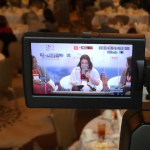“We have data that shows that [online-meeting components] are not a reason that somebody would say, ‘Well, I don’t have to physically go to the event now,’” said Carol McGury, SmithBucklin’s senior vice president of event and education services. “It was more either of an extended offer, a convenience, a solution to keep the community engaged in what is the gathering of the community.”
Hybrid meetings will continue to evolve, she added. “It was quite costly to do a virtual offering five years ago, and somewhat prohibitive. And now, as technology evolves, so does the ability to deliver a higher-end product. People are more creative.”
The technology is also becoming increasingly personal, according to Chris Ballman, SmithBucklin’s director of education and learning services. “The virtual meetings that I’m on now today, compared to even three years ago, it’s night and day [in terms of] the quality of the actual pictures and the people,” he said. “You’re not getting the fuzzy static or the freeze frame that we used to get. It’s a seamless flow throughout the whole meeting, and much higher quality.”
Ballman is borne out by the results of the Virtual Edge Institute’s 2013 Digital Event Benchmarking Report, which surveyed 200 physical and online event producers. Some of the survey results include:
- 80 percent of respondents produce physical events; 70 percent of those also produce online events.
- 80 percent reported that their attendees said that having event content available online was both an incentive and a justification for attending in person.
- 67 percent said that online attendance was up.
- 60 percent said that making “greater use of educational assets” was a major objective of online events.
- The most successful online engagement technologies were attendee chat, social media, and polling/Q&A.



